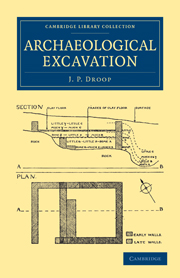CHAP. VI - PUBLICATION
Published online by Cambridge University Press: 07 September 2010
Summary
The excavation is over, all possible subdivisions and all necessary notes, drawings and photographs have been made; over, too, is the period of study in the museum, and what now lies before the excavator is the publication of the results. Somewhere the complete record of the work done should be kept for reference in case subsequent work should reveal interests in the material unsuspected at the time, but it is not advisable to lay all the details open in a publication. For my labour has been vain if I have not made it clear that to do his work properly the excavator must note down all possible observations whether their interest is apparent at the time or not; many of these, probably the greater number, will in the end prove valueless, and it would be like giving a thirsty man salt water to drink to serve them up to a public hungry for knowledge. There is too great a tendency in modern archaeological work to swamp the interest of the results with a flood of detailed evidence, that makes the dreariest reading, and often is its own undoing, for only those conclusions that reach the highest point of interest can survive. To take an instance: an excavation of quite moderate extent might easily embrace a hundred and fifty sections more or less productive, each of which might have six or seven vertical sections; at headquarters there should be a record of the contents of these thousand subdivisions, but to print page after page of these details would be nauseating.
- Type
- Chapter
- Information
- Archaeological Excavation , pp. 58 - 62Publisher: Cambridge University PressPrint publication year: 2010First published in: 1915



